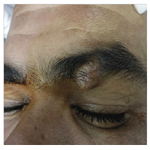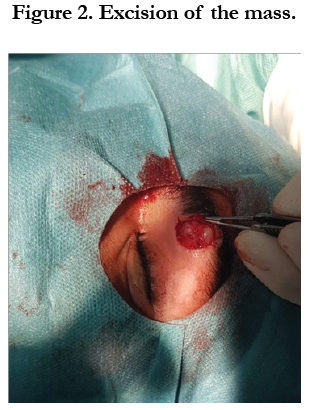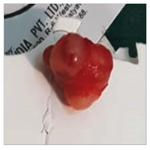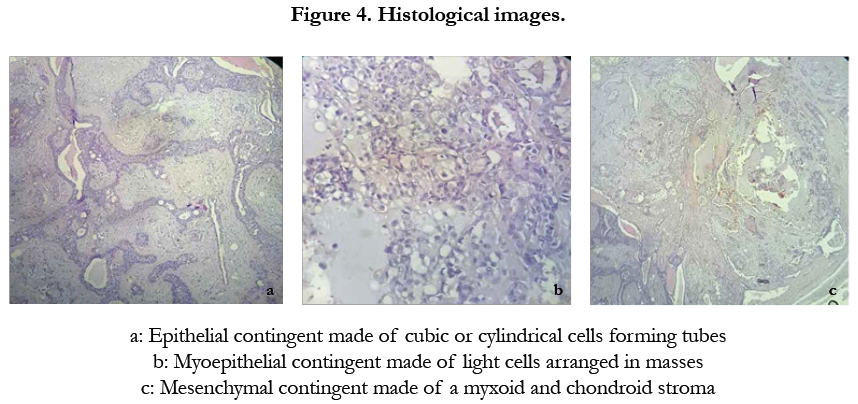Unusual Lesion of the Eyebrow: A Case Report of Chondroid Syringoma
C. Filali1*, M. Abdellaoui1, F. Chraibi1, C. Saadani2, F.Z. Mernissi2, A. Douida3, N. Hammas3, D. Benatiya1
1 Department of Ophthalmology, CHU Hassan II Fez, Morocco.
2 Department of Dermatology, CHU Hassan II Fez, Morocco.
3 Department of Anatomopathology, CHU Hassan II Fez, Morocco.
*Corresponding Author
Choaib El Amine Filali,
Department of Ophthalmology, CHU Hassan II Fez, Morocco.
Tel: +212622761032
Fax: 622761032
E-mail: Prtiae@gmail.com
Received: March 18, 2019; Accepted: April 08, 2019; Published: April 09, 2019
Citation: C. Filali, M. Abdellaoui, F. Chraibi, C. Saadani, F.Z. Mernissi, A. Douida, et al., Unusual Lesion of the Eyebrow: A Case Report of Chondroid Syringoma. Int J Ophthalmol Eye Res. 2019;7(1):397-399. doi: dx.doi.org/10.19070/2332-290X-1900080
Copyright: C. Filali© 2019. This is an open-access article distributed under the terms of the Creative Commons Attribution License, which permits unrestricted use, distribution and reproduction in any medium, provided the original author and source are credited.
2.References
Brief Report
Chondroid syringoma is a rare mixed tumor accounting for only 0.01% of all primary skin tumors [1]. Though it’s very common occurrence is in head and the neck region, involvement of eyelids is extremely rare [2]. These are usually a slowly growing, asymptomatic, solitary, non ulcerating masses ranging between 0.5cm and 3.0cm in size [2]. Herein we report another rare case of chondroid syringoma of eyebrow in a young man.
A 45-year-old man presented to us with a slow growing, painless and solitary mass on his left eyebrow that has been present for 4 years. Physical examination showed a solid, well demarcated left eyebrow mass, measuring approximately 1.5cm in size, with emergence of hair. On palpation it was firm and not fixed to underlying tissues (Figure 1). The differentials diagnosis were dermoid cyst, sebaceous cyst or dermal nevi, nevi. Ocular examination was normal: ocular motility was not reached. Visual acuity was correct.
An excision under local anesthesia was performed (Figure 2). The wound was closed directly with no flap reconstruction was needed. Macroscopically, the tumor nodule had a well-circumscribed appearance with a pinkish color and measured 15mm in diameter (Figure 3). Histopathologic examination showed that the tumor was relatively well-circumscribed and located in the mid and deep dermis, composed of both epithelial and mesenchymal components (Figure 4). The epithelium was composed of tubules lined by low cuboidal epithelial cells surrounded by myoepithelial cells. Myoepithelial cells blended into the surrounding stroma, in some areas forming sheets. The mesenchymal was chondroid and myxoid. No atypical cells or mitoses were noted. The histopathologic findings were consistent with chondroid syringoma. The patient has been followed up at 6-month intervals and remained free of recurrence at 12 months follow-up.
Chondroid syringoma is a skin appendage tumour histopathologically similar to the mixed tumour (pleomorphic adenoma) of the salivary glands [3]. Helwig later classifed this tumor type as chondroid syringoma in 1961 due to the presence of sweat gland elements in a cartilaginous stroma [1]. Incidence of chondroid syringoma is between 0.01% and 0.1% of all skin lesions. Chondroid syringomas most commonly occur in the head and neck regions. Only few cases of chondroid syringoma in the periorbital region were reported [1]. Tumors usually range in size from 0.5 cm to 3.0cm and are typically asymptomatic, firm, slow-growing, solitary nodule [3]. In the periocular location, chondroid syringoma is more common in the upper eyelid and brow area; more rarely, it affects the lower eyelid and the orbit [4]. The differential diagnosis of chondroid syringoma may include a variety of periorbital lesions, such as neurofibroma, dermoid cysts, sebaceous cysts, dermatofibroma, salivary gland pleomorphic adenoma, or basal cell carcinoma. No specific signs of chondroid syringoma differentiate it from other eyelid tumours. Histopathologic examination is indispensable for a correct diagnosis, demonstrating nests of cells and ducts surrounded by chondromyxoid stroma. The tumor may arise from eccrine or apocrine sweat glands, with some tumors showing features of both types. The apocrine tumor type is more common and characterized by branching lumina lined by 2 layers of epithelial cells. The eccrine type, in contrast, has smaller lumina lined by a single epithelial layer. The mesenchymal stroma may be chondroid, myxoid, or both of them, as in the present case, or adipocytic, or fibrous. Chondroid syringoma is a benign tumor but incomplete excision can undergo malignant transformation [4]. The risk of malignancy increases with giant chondroid syringomas greater than 3.0cm in size [5]. This report indicates that chondroid syringoma, although rare, should be considered in the differential diagnosis of large eyelid and eyebrow tumors. Excisional biopsy remains the treatment of choice, and histopathological assessment should be obtained to confirm the diagnosis and identify any signs of malignancy.
References
- Hudson LE, Craven CM, Wojno TH, Grossniklaus HE. Giant Chondroid Syringoma of the Lower Eyelid. Ophthalmic Plast Reconstr Surg. 2017 Mar/Apr;33(2):e43-e44. doi: 10.1097/IOP.0000000000000716. PubMed PMID: 27203613.
- Kumar MA, Srikanth K, Vathsalya R. Chondroid syringoma: a rare lid tumor. Indian J Ophthalmol. 2013 Jan-Feb;61(1):43-4. doi: 10.4103/0301- 4738.105060. PubMed PMID: 23275227.
- Kau HC, Tsai CC. Giant chondroid syringoma of the eyelid. Can J Ophthalmol. 2013 Aug;48(4):e63-4. doi: 10.1016/j.jcjo.2013.01.012. PubMed PMID: 23931483.
- Gündüz K, Demirel S, Heper AO, Günalp İ. A rare case of atypical chondroid syringoma of the lower eyelid and review of the literature. Surv Ophthalmol. 2006 May-Jun;51(3):280-5. PubMed PMID: 16644368.
- Mlika M, Fadhel CG, Lahmar A, Rekik W, Lafif FH, Bouraoui S, et al. An unusual tumor of the eyelid. Ann Pathol. 2009 Jun;29(3):249-51. doi: 10.1016/j.annpat.2009.02.016. PubMed PMID: 19619836.













